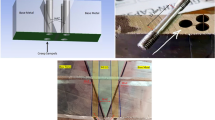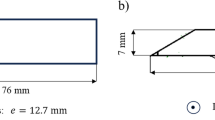Results of experimental studies of low-carbon steel 20 and high-carbon steels of types 70 and 65G after carburizing, heat treatment and laser hardening are presented. The variation of the microhardness of the surface layers of the steels and of their wear resistance due to different variants of hardening is determined. Optimum modes of treatment aimed at raising the strength and wear resistance are suggested for the steels used for working members of cultivating machines.





Similar content being viewed by others
References
Y. Bayhan, “Reduction of wear via hardening of chisel plough-share,” Tribol. Int., 39, 570 – 574 (2006).
Z. Horvat, D. Filipovic, S. Kosuti, and R. Emert, “Reduction of mouldboard plough share wear by a combination of technique of hardfacing,” Tribol. Int., 41-8, 778 – 782 (2008).
T. F. Akhmetshin, “Raising the wear resistance and endurance of cultivating working members,” Izv. Orenburg. GAU, No. 3, 81 – 84 (2013).
A. Yu. Izmailov, S. A. Sidorov, Ya. P. Lobachevskii, et al., “Scientific principles of elevation of wear resistance of working members of cultivating machines,” Vestn. Ross. Akad. Sel’skokhoz. Nauk, No. 3, 5 – 7 (2012).
A. T. Lebedev and R. A. Magomedov, “Wear resistance of driven elements of cultivating machines,’ Sel’sky Mekhaniz., No. 10, 34 – 35 (2011).
A. Yaziki, “A study of wear of carbonitrided plow shares from steel 30MnB5 for tillage,” Metalloved. Term. Obrab. Met., No. 5, 46 – 51 (2011).
A. Natsis, G. Petropoulos, and C. Pandazaros, “Influence of local soil conditions on mouldboard ploughshare abrasive wear,” Tribol. Int., 41, 151 – 157 (2008).
B. N. Orlov, “Effect of operating conditions on the wear resistance of working members of cultivating machines,” Mekhaniz. Elektrif. Sel’sk. Khoz., No. 4, 24 (2006).
V. I. Pyndak, “Raising the wear resistance of machine parts by laser hardening,” Tekhn. Sel’sk. Khoz., No. 1, 32 (1995).
G. A. Turichin, E. V. Zemlyakov, E. Yu. Pozdeeva, et al., “Technological possibilities of laser surfacing with the use of powerful fiber lasers,” Metalloved. Term. Obrab. Met., No. 3, 35 – 40 (2012).
A. S. Ivanov, S. S. Tikhomirov, E. N. Kozlova, et al., “Formation of structure and properties of surface layers under carburizing of low-carbon martensitic steels,” Perspekt. Mater., No. 6, 72 – 79 (2006).
E. N. Aseeva, Formation of High Tribotechnical Properties in Parts by Laser Treatment, Author’s Abstract of Candidate’s Thesis [in Russian], Volgograd (2000), 19 p.
V. L. Pyndak and A. E. Novikov, “Energy efficiency of mechanisms and instruments for deep cultivation of soil,” J. Machin. Manuf. Reliabil., 43(6), 532 – 536 (2014).
Author information
Authors and Affiliations
Corresponding author
Additional information
Translated from Metallovedenie i Termicheskaya Obrabotka Metallov, No. 4, pp. 39 – 44, April, 2016.
Rights and permissions
About this article
Cite this article
Pyndak, V.I., Novikov, A.E. Tribotechnical and Energy Assessment of Parts of Working Members of Cultivating Machines After Carburizing and Laser Hardening. Met Sci Heat Treat 58, 226–230 (2016). https://doi.org/10.1007/s11041-016-9994-7
Published:
Issue Date:
DOI: https://doi.org/10.1007/s11041-016-9994-7




